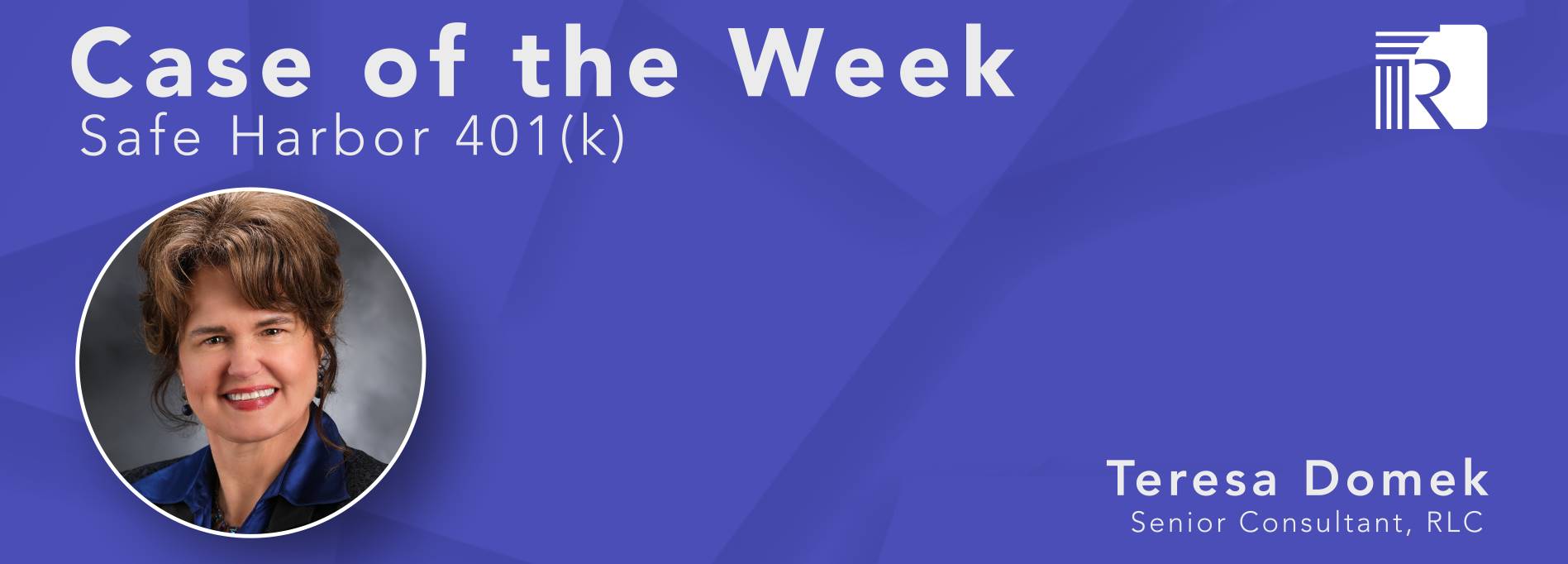
Converting an Existing 401(k) Plan to a Safe Harbor Design
A 401(k) plan sponsor has some flexibility when converting its existing plan to a safe harbor design. The type of safe harbor contribution affects notice and amendment deadlines.
Welcome to the Retirement Learning Center’s (RLC’s) Case of the Week. Our ERISA consultants regularly receive calls from financial advisors on a broad array of technical topics related to IRAs, qualified retirement plans and other types of retirement savings and income plans, including nonqualified plans, stock options, Social Security and Medicare. This is where we highlight the most relevant topics affecting your business. A recent call with a financial advisor in California is representative of a common question on safe harbor 401(k) plans.
“What is the deadline for converting an existing 401(k) plan to a standard safe harbor plan?"
Highlight of the discussion on 401(k) plan safe harbor conversions
There are multiple deadlines based on the situation. The deadlines for converting an existing 401(k) plan to a standard safe harbor arrangement depends on the type of safe harbor contribution the plan sponsor selects. Employers may choose between implementing a safe harbor match or a safe harbor nonelective contribution, as discussed below.
Safe Harbor Match
In general, the two types of safe harbor matching formulas include:
Basic Match: 100% of the first 3% deferred, and 50% on the next 2% deferred; and
Enhanced Match: The matching contribution formula provides a match that is at least equal to the aggregate match that would be provided under the basic match formula (i.e., 4%) up to 6% of compensation. To avoid nondiscrimination Actual Contribution Percentage (ACP) testing, the match cannot exceed 6% of compensation.
Nonelective Contribution
Section 103 of The Setting Every Community Up for Retirement Enhancement (SECURE) Act of 2019 gave employers added flexibility by extending the deadline for amending their 401(k) plans to provide a safe harbor nonelective contribution. The amendment deadline depends on the amount of the nonelective contribution.
The two forms of safe harbor nonelective contributions include:
At least 3% of compensation; and
At least 4% (or more) of compensation.
Existing 401(k) Plan | Add SH Match | Add 3% SH Nonelective | Add 4% SH Nonelective |
Formula | Basic or Enhanced Match | 3% of compensation | 4% of compensation |
Notice Deadline | At least 30 (but not more than 90) days before the first day of the plan year (e.g., December 1 for a calendar-year plan) See Issue Snapshot -Notice Requirement for a Safe Harbor 401(k) or 401(m) Plan) | N/A The SECURE Act ended the participant notice requirement for safe harbor nonelective contributions. | N/A SECURE Act ended the participant notice requirement for safe harbor nonelective contributions. |
Plan Amendment Deadline | Last day of plan year prior to the effective date of safe harbor provision (e.g., by December 31 for a calendar-year plan) | At any time prior to the 30th day before the end of the plan year (e.g., by December 1 for a calendar year plan) | By the end of the following plan year (e.g., by December 31 for a calendar-year plan) |
Example | DRM Company, Inc., (DRM) currently sponsors a calendar-year 401(k) plan and decides to add a safe harbor match, effective January 1, 2025. DRM has until December 31, 2024, to adopt the plan amendment, but must distribute the safe harbor matching contribution notice to participants no later than December 1, 2024. | ABC Company, Inc., (ABC) currently sponsors a calendar-year 401(k) plan and preliminary Actual Deferral Percentage (ADP) nondiscrimination testing shows the plan is failing. Prior to December 1, 2024, ABC may amend its plan to provide a 3% safe harbor nonelective contribution to eligible participants for the 2024 plan year. | XYZ Company Inc., (XYZ) did not do a preliminary ADP testing for 2024. In February 2025, it discovers that the 2024 ADP test failed. XYZ has until December 31, 2025, to amend its plan to provide a 4% nonelective contribution for all eligible employees for the 2024 plan year and pass 2024 ADP testing. NOTE: Employer contributions must be made by the employer’s tax filing deadline (plus extensions) to be deductible. |
Conclusion
Safe harbor plan design options may allow plan sponsors to bypass ADP/ACP testing in certain circumstances or correct failed ADP/ACP testing in other circumstances. Employers should be aware of the deadlines for converting an existing 401(k) plan to a safe harbor design.
